How to Allocate Resources in Project Management: 8 Steps to Succeed

Audio version:
If you plan and manage projects, you should know how professional resource management is significant. No matter whether it’s about resource allocation in an IT startup or asset distribution for a complex marketing campaign.
How to allocate resources in project management to decrease potential risks and bring your project to a desired finish line? Are there consistent steps to follow and suitable software to achieve success in this field?
You’ll find the answers in this article, so let’s get straight to the point.
Contents:
The primary goal of resource allocation is to prevent potential shortages by strategically planning and aligning essential resources for timely project completion.
You will hardly find any project without resources involved. Understanding how to allocate resources in project management can make the difference between any project’s success or failure. Project managers are well aware of this fact. Therefore, they try to bring their resource management skills to perfection and create an appropriate resource management plan.
The authors of the survey conducted in 2023 asked 217 PM professionals about the biggest concerns related to their projects at that moment.
The top 5 answers were:
- Insufficient project resources (44%).
- Unachievable deadlines (31%).
- Inadequate resources (26%).
- Limited finances (17%).
- Poor project quality (13%).
The participants of another survey, published in the Wellington report (2021), also admitted that resource management is the 3rd biggest challenge for PM professionals.
There is one more illustrative example. The relevance and actuality of the resource management process are often discussed by the official partners of McKinsey & Company. For example, Aaron De Smet and Tim Koller, strongly emphasize the need for proper resource allocation. In their article, they note:
Effective resource allocation means ensuring, consistently and proactively, that strategically important businesses receive the capital, talent, and management attention they need — so long as the growth thesis remains robust.
It is needless to argue with the facts and comments of real experts. They demonstrate the complexity and relevance of this essential PM process.
In our high-tech world, most processes are automated. Resource allocation methods in project management also become simpler and clearer if they are implemented with the help of powerful software.
Below we detail the role and power of modern tools for resource allocation.
Why is it critical to use software solutions for resource allocation in project management?
A resource management tool plays a vital role in efficient allocation and supervision of human resources, time, finances, equipment, and various materials. This software category assists companies in planning strategies, organizing schedules, monitoring progress, and forecasting project management resources to achieve required business goals.
For instance, in the IT sector, an online resource management system can be utilized to allocate servers, IT professionals, software licenses, and other essential resources to ensure the successful completion of IT projects.
Managers often rely on resource calendars and professional online solutions to make critical decisions regarding team composition and necessary assets. These solutions help minimize staff downtime and enable timely response to changes in resource demand throughout their operations.
The significance of resource scheduling tools in PM extends beyond these points. Let’s delve deeper into their importance.
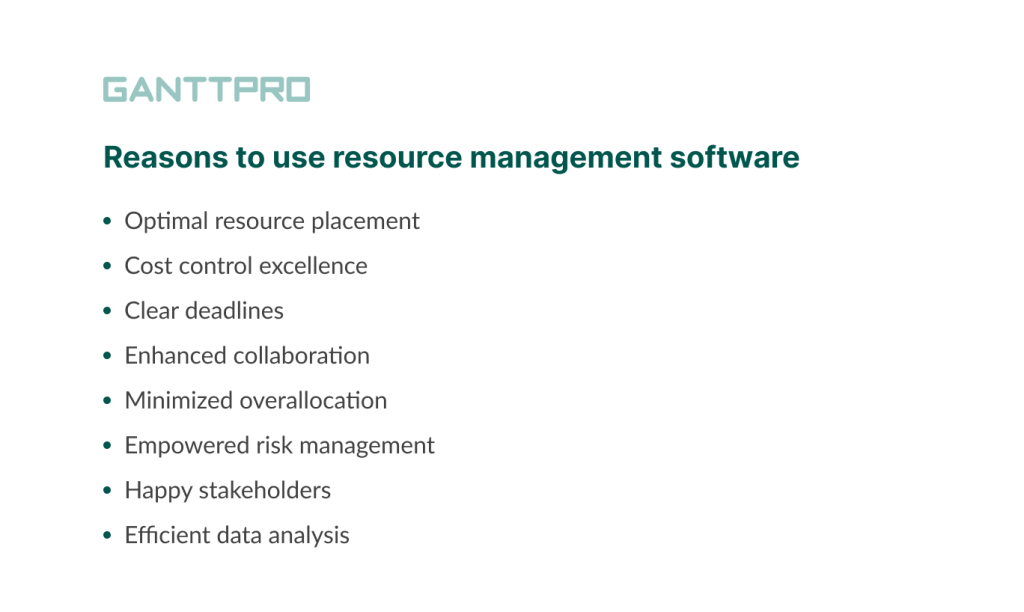
- Optimal resource placement. Before assigning resources to a new project, PMs must evaluate their availability. A well-selected tool reveals existing resources and work requirements. It assists in allocating human and non-human resources.
- Cost control excellence. Advanced software for resource scheduling efficiently manages project expenses by allocating resources only as required, mitigating unnecessary costs and financial overruns.
- Clear deadlines. Effective resource allocation guarantees the availability of skilled individuals when needed. They control and manage project deadlines and key milestones.
- Enhanced collaboration. Such platforms provide clear visibility into all available resources. It facilitates collaboration among workers and stakeholders that leads to conflict resolution and informed decision-making.
- Minimized overallocation. Utilizing a tool for resource management helps prevent the overcommitment of resources to numerous tasks simultaneously. It reduces possible burnout and ensures employees are not overwhelmed.
- Empowered risk management. Online solutions with the functionality for resource management help teams recognize bottlenecks and resource constraints in advance, enabling proactive issue resolution. Surplus resources can be utilized to acquire new clients.
- Happy stakeholders. Responsible allocation of resources in project management leads to on-time and on-budget project completion. It naturally results in increased satisfaction and positive relationships with clients, partners, sponsors, and other people involved in your project.
- Efficient data analysis. To maximize profitability, managers can evaluate resource allocation against project duration to reach better ROI (return on investment) results. Resource management software solutions provide essential data analysis and automated reporting on project processes, availability, and workloads.
Every single point from this list looks vital. And it’s extremely important to choose proper software for allocating and managing resources that will contain all these characteristics and capabilities.
With a smart resource management tool, you’ll be able to control work processes, labor issues, and financial management in one place. It’ll give you a chance to use resources where they can have the greatest impact.
Modern online management tools come with powerful sets of features. The most advanced platforms rely on an online Gantt chart for overseeing the whole workflow picture.
Want to explore a trustworthy example of such software?
GanttPRO is here.
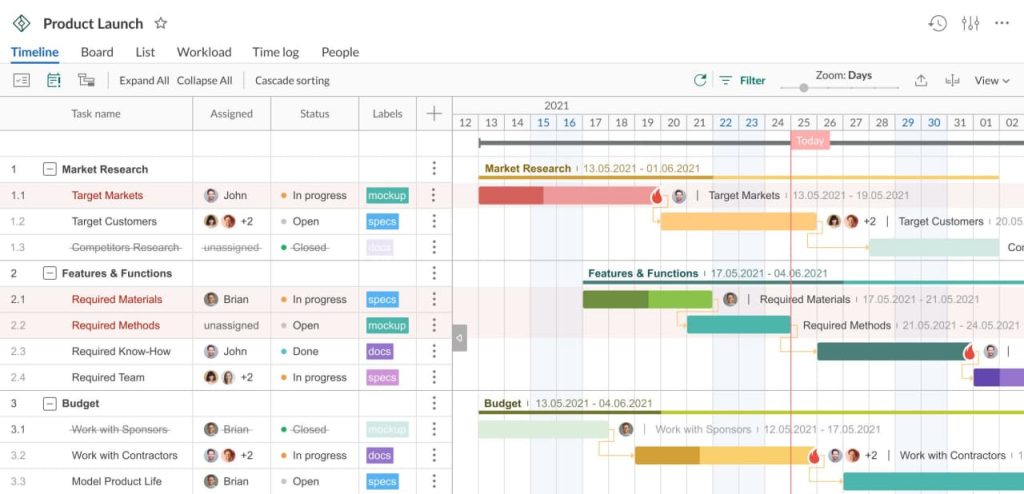
The Gantt chart maker may become a reliable helper for project managers who strive to succeed in PM without switching between different tools, as it provides all essential features in one spot. Using this tool, teams always have a clear understanding of what’s going on in their projects.
The platform offers an online Gantt diagram that allows for scheduling projects and tasks, allocating resources, communicating with teammates, and much more.
GanttPRO is used in many professional areas, including software development, marketing, retail, event planning, manufacturing, construction resource management, and more.

Powerful project and resource management software
Manage resources and control your team’s workload properly.
Sign up for freeWhen you start using GanttPRO, you quickly understand that the tool’s functionality was designed to be intuitive and friendly for all users. Additionally, pre-made Gantt chart templates will help you dive into this platform even faster.
Having such a tool in your arsenal, you can actively begin a step-by-step study of the question “How to allocate resources in project management?”
8 steps that will show you how to allocate resources in project management
If you clearly understand how to allocate resources in project management, you’ll succeed in work coordination, schedule control, and productivity growth. It will assist you in improving workflows and enhancing the likelihood of achieving your business goals.
Utilizing a robust software solution equipped with automation functionality can make the resource allocation process easier and quicker.
Actually, some companies still rely on Excel files or use simple Excel alternatives for this purpose. But why spend precious time when a powerful PM tool can do it for you?
Modern resource management platforms simplify the identification and visualization of project resources. These software solutions offer diverse ways to present project data. They can be customized to suit your team’s specific requirements.
So, below we propose the consistent steps that will help you find the answer to the question “How to allocate resources in project management?”
Let’s have a closer look at them.
- Gather project requirements.
- Prepare a timeline with tasks and subtasks.
- Identify and allocate your best-fit resources.
- Assign relevant resources to certain project tasks.
- Track schedules and deadlines.
- Monitor project progress and control workload.
- Prepare a report.
- Have a change strategy in place.
1. Gather project requirements
Knowing all the ins and outs of a project helps to allocate resources effectively.
Before any work on your project starts, take a moment to consider its size and complexity. This stage also involves identifying all project requirements, including goals and objectives, project scope, and potential deliverables.
Make this step your top priority. Otherwise, you won’t be able to allocate your resources properly.
After all requirements of your project are identified, you can move on to creating a workflow.
2. Prepare a project timeline with tasks and subtasks
It is assumed that you have already selected the appropriate resource management software. For your convenience, we’ll continue describing how to allocate resources in project management using GanttPRO as an example.
So, based on the defined project requirements and estimates, make a project schedule and map it on a handy online Gantt chart timeline.
You’ll need to divide your project into tasks and smaller subtasks. It’s essential to determine due dates and start and end points for each activity as well as keep your colleagues informed about this data.
It may seem like hard work. However, creating a project timeline and adding tasks with GanttPRO is as easy as pie. The Gantt chart generator comes with a work breakdown structure (WBS) that allows for systemizing tasks and breaking them down according to the logical hierarchy of your project strategy.
This visual representation of project activities lets GanttPRO users easily add task dependencies and place project milestones within their timelines. It can be done in seconds with the help of convenient drag-and-drop.
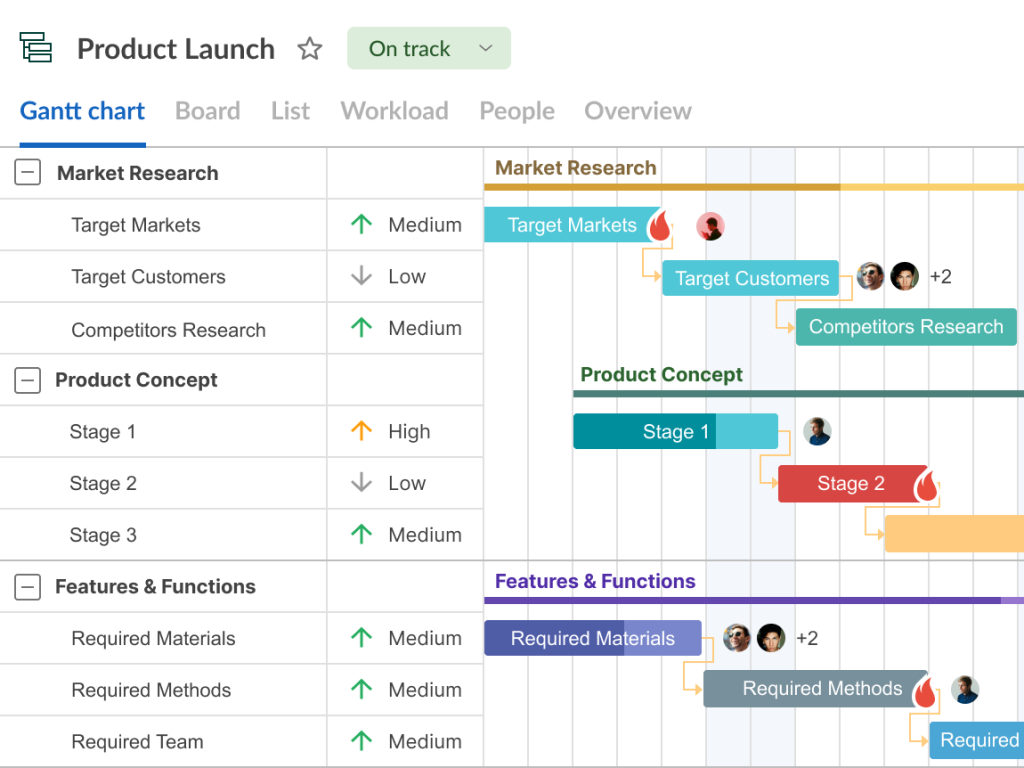
GanttPRO users appreciate that it’s possible to initiate and organize several workspaces and projects at once.
3. Identify and allocate your best-fit resources
After defining tasks, it’s time to gather the necessary resources and invite project participants.
Resources in projects are usually categorized into five groups.
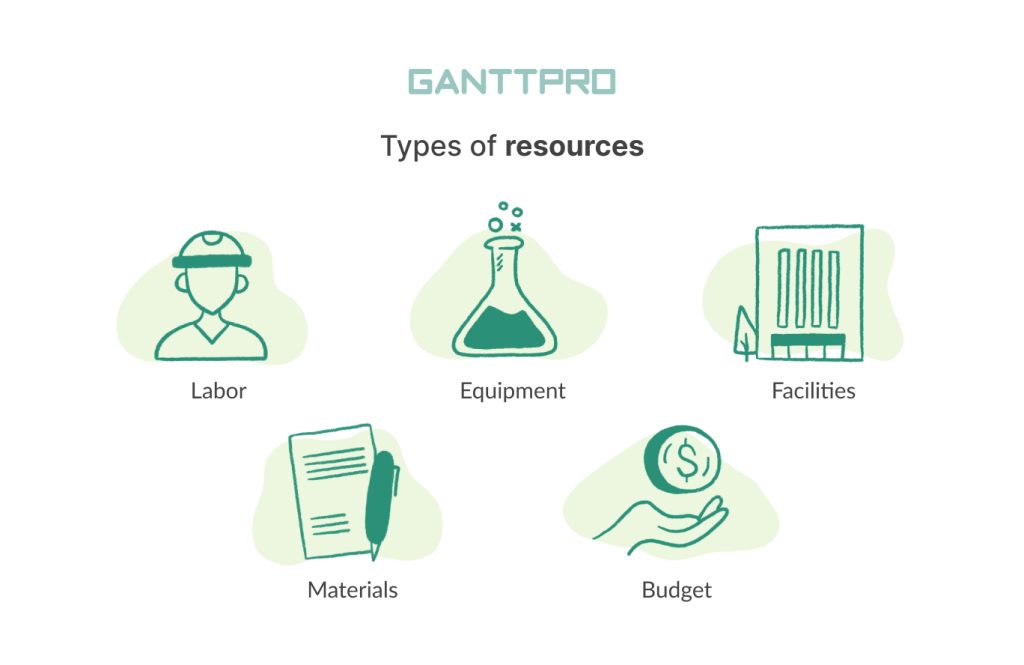
- Labor. These are usually teammates who contribute work to a project.
- Equipment. Here we consider different types of physical tools or software solutions you need to run your project from ideation to completion.
- Materials. Consumable items required for a project: from office supplies to gas for your car.
- Facilities. It’s commonly about workspaces, workshops, meeting rooms, or even buildings where your team works.
- Budget. All money needed for purchasing any of the resources listed above.
It’s worth considering both the quality and quantity of resources needed. For example, human resource quality relies on experience and skills, whereas quantity pertains to the number of individuals or resources required for task completion.
Having reliable software for advanced resource management, you can easily organize human and non-human resources.
Within GanttPRO, it’s pretty easy to invite teammates, manage their calendars, and define costs. The software also allows for the identification of roles and certain responsibilities of all project participants. If you need to give them specific rights to view project data, you can apply different account roles and project rights.
Overseeing resources is equally straightforward within a Gantt chart with resource allocation. It’s possible to add cost for all assets per hour, per item, or just fixed cost.
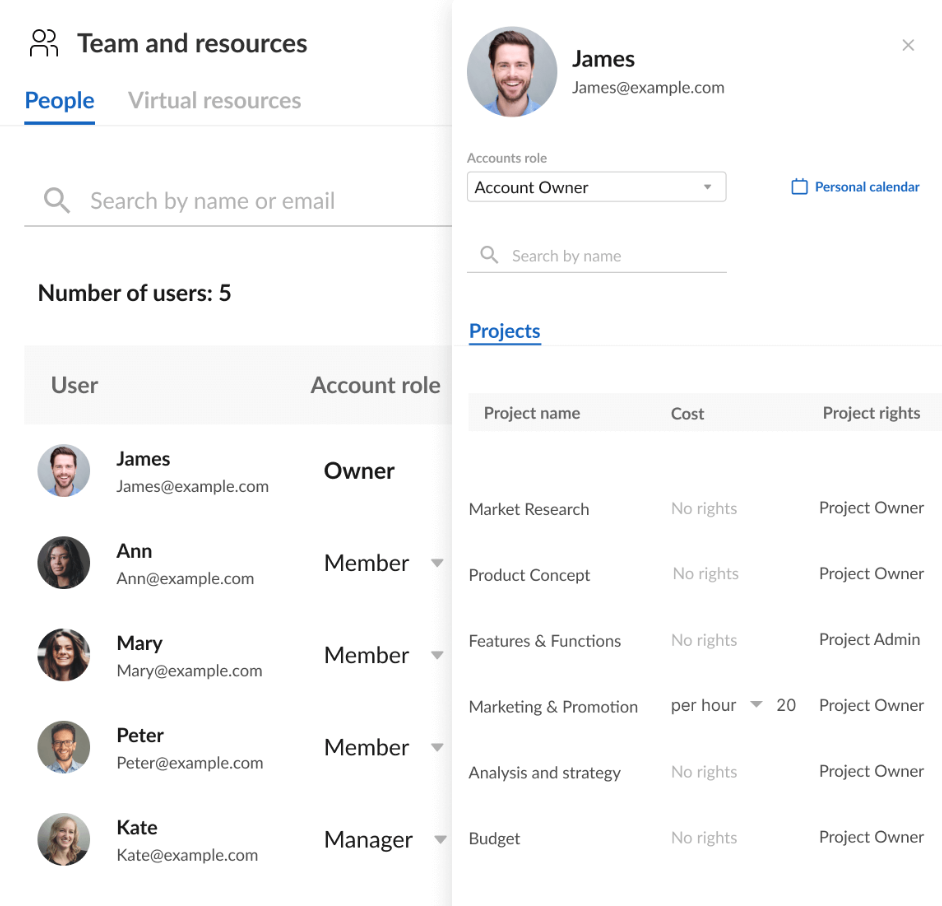
4. Assign relevant resources to certain tasks
Now it’s time to allocate resources to tasks. With a thorough project assessment, assigning resources to various workflow activities should be straightforward.
Being a powerful resource management software, GanttPRO allows for assigning necessary resources and setting their working hours to avoid downtime or overwork.
You can also determine priorities, set estimations, and add statuses to tasks. It helps improve performance and enhances overall efficiency.
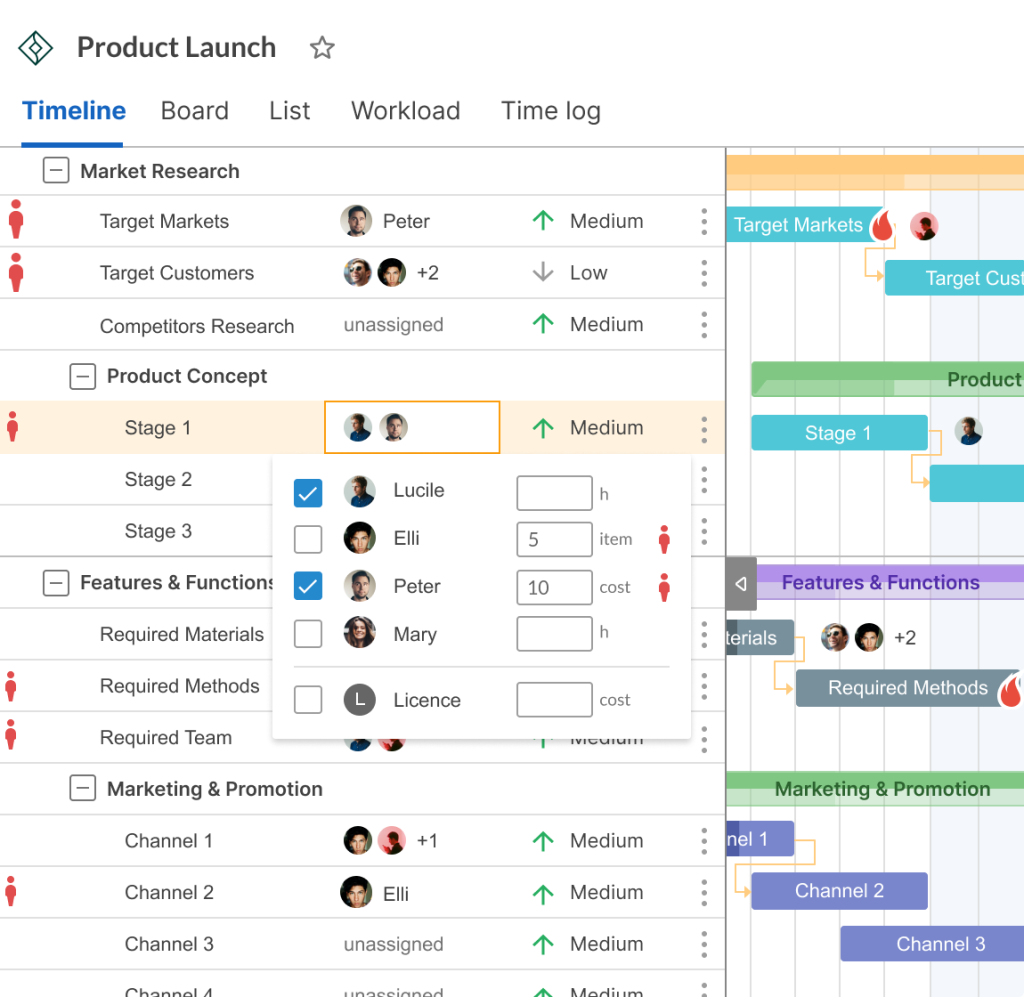
5. Track schedules and deadlines
Project managers should consistently monitor their teams’ progress and ensure efficient task completion.
Even a small overdue dependent task can lead to a project delay. Therefore, timing and deadline control should be a kind of mantra for managers.
GanttPRO allows project teams to:
- Maintain schedules for completing every single task.
- Control deadlines.
- Track employees’ activity.
- Avoid project delays.
- Analyze data collected and stored, all in one spot.
The software also provides online notifications that facilitate work distribution in any type of team, allowing them to finish work promptly. These notifications timely inform individuals about the upcoming end of a task.
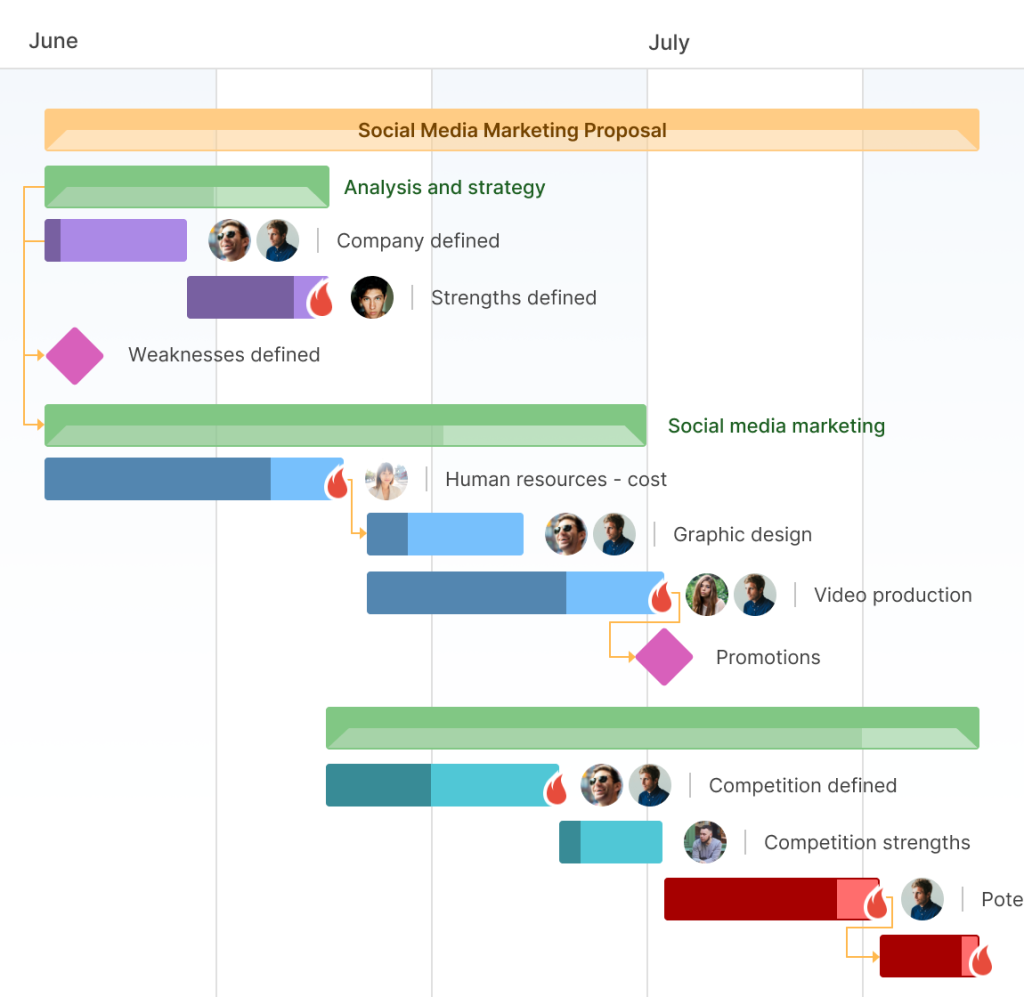
6. Monitor project progress and control workload
Managers should regularly oversee the progress and working hours of their team members. This monitoring helps identify workers capable of handling additional tasks to expedite project completion or, conversely, prevent excessive workload.
GanttPRO offers workflow capabilities, streamlining data management and centralizing essential information in one place.
This is actually appreciated by PMs all over the world. For example, Allan Cid, an experienced project manager, shares his thoughts on this matter:
I like that I can create a workload for my team. This way, I can measure whether I give too much workload to a worker on a project or not. GanttPRO sorts out the hours used in different projects. So, if I have a worker working on Project A, Project B, and Project C, I can see what their workload looks like for a week or a day and reassign tasks if needed. That’s great.
The workload feature in GanttPRO helps to:
- Track assignees’ availability. The workload window in GanttPRO is located right under a timeline. With its help, you can track how many working hours or tasks each worker has every day.
- Reassign tasks. The handy drag-and-drop feature will help you quickly redistribute tasks if needed. When an assignee is overloaded, you’ll see a red human icon near it.
- Set up personal calendars. These calendars seem helpful especially when a manager runs a complex project. With their help, you will always be aware of all significant dates and events, including days off, vacations, anniversaries, holidays, and other dates.
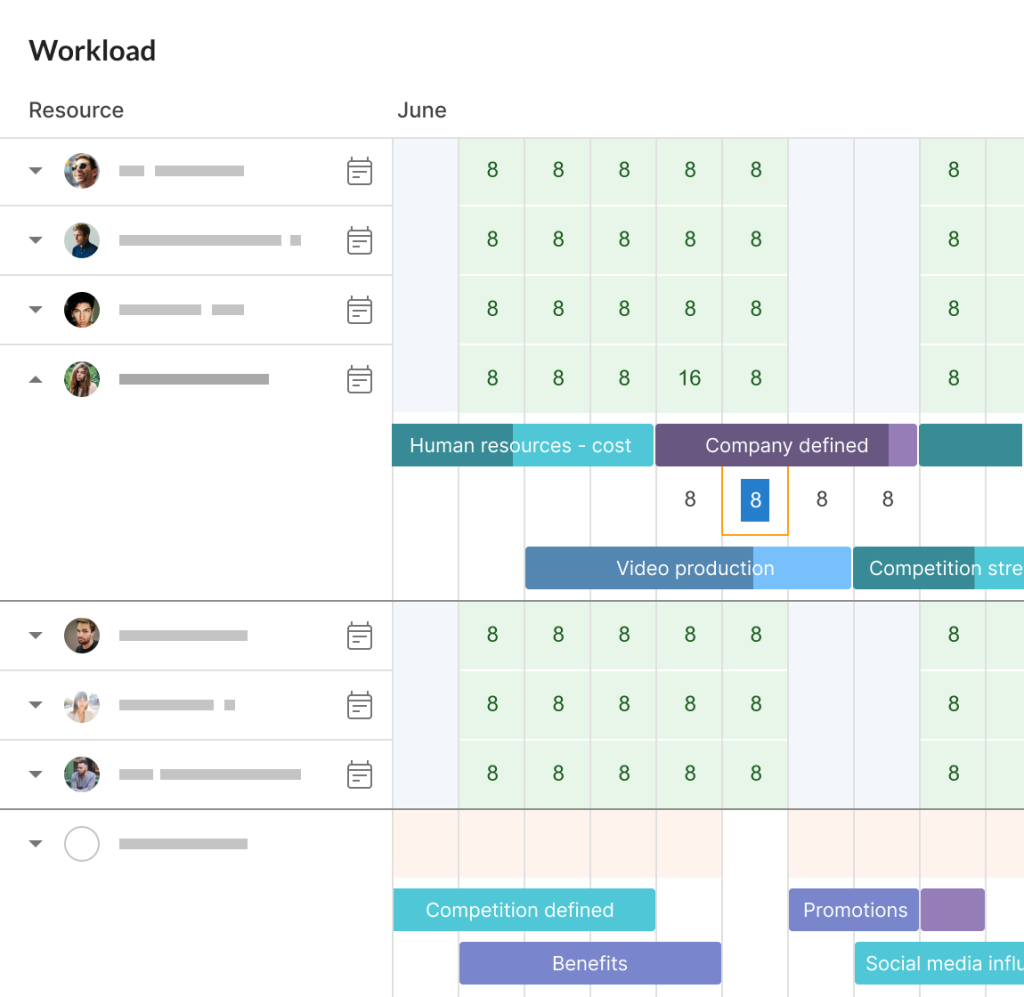
7. Prepare reports
While your project may not have reached its completion, it’s crucial to proactively utilize current data on work processes and available resources for result assessment, optimization, and future planning.
Comprehensive reporting helps managers and teams to collect valuable information about essential resources, thereby optimizing their time usage.
In GanttPRO, all information is synchronized in real time, so users don’t need to compile reports manually.
They can create two types of reports:
- Time log by people.
- Budget analysis.

8. Have a change strategy in place
The process of restructuring a cost plan is well-known for many experienced managers, especially if they deal with resource planning for multiple projects. This is only one example of change management.
The process of resource changes may have different forms depending on whether you require customer approval to make related changes to your plans.
If you get more change requests than anticipated, this can mean that you have to request extra resources from your customers or stakeholders.
Therefore, remember that projects rarely go completely according to a plan. There can be many borders and bottlenecks on your way. And in terms of resource allocation perspective, there can be staffing or budget changes you didn’t anticipate.
Try to always have a plan B. Your skills and experience will help you understand the priority level of each resource and realize which resource dependencies you should care about.
That’s all about it.
The listed steps are fundamental but they can be easily complemented with additional ones. Anyway, they should be enough for you to learn the resource management basics.
Boost your skills to always be aware of how to allocate resources in project management
Proper organization of work resources plays a vital role in the success of any project. If you strive to know how to allocate resources in project management with maximum benefits, you have to start with the basic theory and then get down to business.
The trivial truth is that effective resource allocation leads to better business results.
Consider the steps described above – they will guide you to the right thoughts about efficient resource allocation.
Let’s briefly sum up those steps:
- Define a project scope and other requirements.
- Generate a timeline and add tasks.
- Find and visualize project resources.
- Assign your resources to certain tasks.
- Track deadlines.
- Control workload.
- Succeed in reporting.
- Be ready for changes.
Improve your project completion rates with effective resource allocation performed with a powerful tool such as GanttPRO and save precious time for other important things.

